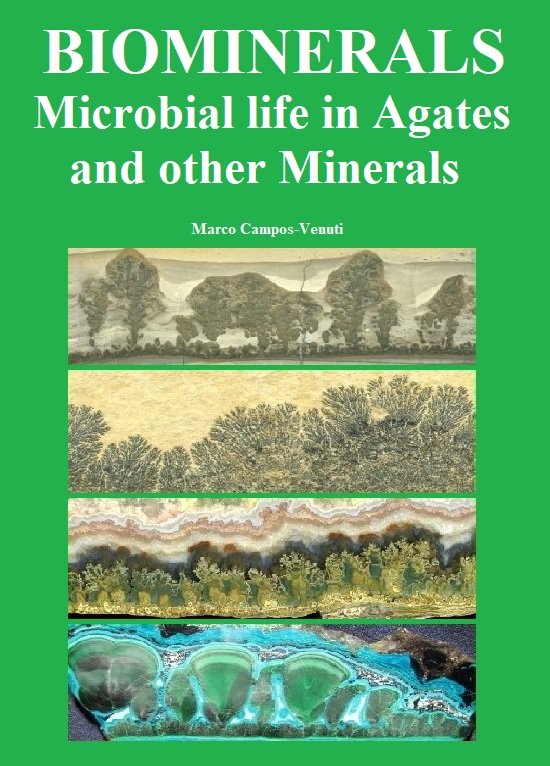| View previous topic :: View next topic |
| Author |
Message |
marco campos-venuti

Joined: 09 Apr 2014
Posts: 234
Location: Sevilla



|
 Posted: May 18, 2023 08:16 Post subject: Re: An idea for a collection Posted: May 18, 2023 08:16 Post subject: Re: An idea for a collection |
|
|
About the relationship between mineralogy and biology I recently published a voluminous book entitled "Biominerals: Microbial Life in Agates and other Minerals". In this work I try to identify structures of biological origin in hundreds of mineral samples that would normally be placed in mineral showcases. The results indicate that biomineral structures are much more common than we might imagine.
You can find the book here:
https://www.agatesandjaspers.com/
(link normalized by FMF)
528 pages, +1000 figures, 78 diagrams
| Description: |
|
| Viewed: |
22278 Time(s) |

|
|
|
| Back to top |
|
 |
James Catmur
Site Admin

Joined: 14 Sep 2006
Posts: 1482
Location: Cambridge



|
 Posted: May 18, 2023 09:53 Post subject: Re: An idea for a collection Posted: May 18, 2023 09:53 Post subject: Re: An idea for a collection |
|
|
| I like the Cotham marble
|
|
| Back to top |
|
 |
Roger Warin

Joined: 23 Jan 2013
Posts: 1246



|
 Posted: May 18, 2023 10:17 Post subject: Re: An idea for a collection Posted: May 18, 2023 10:17 Post subject: Re: An idea for a collection |
|
|
I have everything to learn in this area.
What is the mechanism that initiates this type of biomineral growth?
I only know (but am only an amateur) one mineral of bacterial origin. Gold scales.
I believe that these bacteria play the role of a mineralizing agent that patiently concentrates the highly disseminated gold in the rocks. They would play a parallel role to classical agents, such as selenides and tellurides.
|
|
| Back to top |
|
 |
James Catmur
Site Admin

Joined: 14 Sep 2006
Posts: 1482
Location: Cambridge



|
|
| Back to top |
|
 |
marco campos-venuti

Joined: 09 Apr 2014
Posts: 234
Location: Sevilla



|
 Posted: May 19, 2023 11:30 Post subject: Re: An idea for a collection Posted: May 19, 2023 11:30 Post subject: Re: An idea for a collection |
|
|
Hi Roger,
I am a geologist and I had to document myself to do an interdisciplinary work between geology and biology. This is why I added an initial chapter to the book to explain the basic concepts to the less experienced. Despite there is an extensive literature on extremophile bacteria, there is almost nothing written about the relationship between their biomineralizing activity and mineral structures known to mineralogists. And my book tries to identify these structures.
In practice, bacteria breathe by exploiting the energy of redox reactions that are often already active in the surrounding environment. The outer surface of the bacterium has a mucous gel which becomes negatively charged and which therefore attracts positive metal ions. The oxidation or reduction of these ions allows the bacterium to obtain energy, but indirectly precipitates oxides, sulfides or other minerals. Many pseudofossils such as dendrites and moss agates are actually true fossils, or at least fossil tracks that we can call microbialites, of which stromatolites are a type that forms with the collaboration of cyanobacteria, i.e. under sunlight. Microbalites form in many environments of the deep biosphere and are associated with common minerals such as agate, malachite, rhodochrosite, sphalerite, as well as gold, silver and copper.
|
|
| Back to top |
|
 |
marco campos-venuti

Joined: 09 Apr 2014
Posts: 234
Location: Sevilla



|
 Posted: May 19, 2023 11:38 Post subject: Re: An idea for a collection Posted: May 19, 2023 11:38 Post subject: Re: An idea for a collection |
|
|
Hi James,
Cotham Marble is a well-known and well-studied stromatolite with dendritic-plumy shapes. The second photo of the cover represents a manganese dendrite, which I theorize precipitated from a colony of bacteria in an epigenetic crevice. The third photo represents a plume agate with structures that recall those of living bacterial colonies and which again I theorize are biomineralized by bacteria. The last photo is a feather malachite. All four samples repeat the same geometric pattern with the growth of dendritic-plumy structures starting from a linear biofilm.
|
|
| Back to top |
|
 |
|





